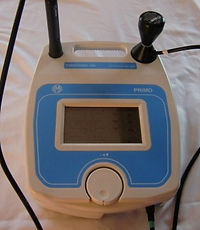
What is Physiotherapy?
Animal Physiotherapy is a complementary therapy provided under Veterinary Referral used to aid rehabilitation, maintain health, mobility, function and performance in all animals, not only for your top athlete, but for your best friend.
Whether we choose to call ourselves Animal Physiotherapists or Veterinary Physiotherapists, in essence our goals remain the same. Whilst my core clients are canines and equines, every animal can benefit from physiotherapy and to date my success stories have included some interesting cases.
In today's world, animals have become a huge part of our lives, either offering companionship, working with us, or being our competition partner. Like us, animals are susceptible to injury, disease and ageing limbs. Working alongside your veterinary surgeon we can treat a range of conditions associated with the animals daily routine.

Animal Physiotherapy involves the assessment and treatment of musculoskeletal and/or neurological conditions in animals. It combines movement analysis with knowledge of anatomy of the musculoskeletal system and nervous system in order to treat a variety of conditions.
THE MOST COMMON AREAS OF TREATMENT ARE:
-

Performance enhancement and treatment of musculoskeletal injuries in the ridden horse and working or competition dog.

Enhancement of quality of life in patients with degenerative conditions such as arthritis – slowing degeneration and treating compensatory muscle spasm.

Post operative rehabilitation for animals with orthopaedic or neurological conditions.
Performance enhancement and treatment of musculoskeletal injuries in the ridden horse and working or competition dog.
Post operative rehabilitation for animals with orthopaedic or neurological conditions.
Enhancement of quality of life in patients with degenerative conditions such as arthritis – slowing degeneration and treating compensatory muscle spasm.
In optimum conditions, nature will heal an injury in a particular time span. However, for many reasons, these conditions are not always readily available. In these circumstances the injury will take longer to heal than nature intended or at worst fail to heal. The aim of physiotherapy is to optimise these conditions so that the body can heal the injury in its natural time span.
What conditions can physiotherapy help with?
-
Osteoarthritis
-
Hip/ Elbow Dysplasia
-
Hind limb weakness/ ataxia
-
Neurological Conditions
-
Fractures/ orthopaedic operations
-
Cruciate Repair
-
Poor Performance
-
Degenerative Joint Disease's
-
Kissing Spine/ Spondylosis
-
Wounds
-
Non-Union Fracture repairs (fractures that aren't healing)
-
Back pain/ reactivity
-
Palative Care
-
Muscle tightness/ spasm/ atrophy/ strains
-
Soft Tissue Injuries
-
Ruptured or damaged ligaments/ tendons
-
Mud Fever/ Rain Scould
-
Cracked Mouths/ Gingivitis
-
Sacroiliac Injury
-
Assist in wound repair to minimise proud flesh







PHYSIOTHERAPY IS DELIVERED BY:
-
Massage: This helps to relax the patient, increasing the blood supply which in turn kick starts the natural healing process and flushes toxins out of the musculoskeletal system. It relieves muscle tension, tightness, spasms and knots to aid the patient to move more freely, provide pain relief and reduce stiffness.
-
Passive Stretches: Stretches performed by the therapist with no muscular input from the patient.
-
Active Stretches: Stretches are performed by the patient by performing movements as guided by the therapist
-
Advice and Exercises such as:
-
Home exercises to perform to aid your animal
-
Exercise regimes to encourage natural healing of an injury
-
Home routine advice and how certain activities your animal performs may be hindering the healing of an injury
-
Weightloss advise for the overweight patient
-







Physiotherapeutic Equipment:
-
Red Light Phototherapy: Is used on every patient as it releases endorphins, encouraging the patient to relax, kick starts the healing process, increases circulation and stimulates cells. Due to this, it works in order to aid wound repair, encouraging epithelial growth and healthy granulation, being a great tool in wound management and repair. It can be used over acupuncture points having the adding benefit of initiating a reaction similar to that of acupuncture or acupressure.
-
Blue Light Phototherapy: This is mainly used in the management of bacterial infections and wounds. It has an antibacterial effect at a superficial level and used promptly on fresh wounds will reduce the risk of contamination.
-
Pulsed Electro-Magnetic Field Therapy: Influences cell behaviour by inducing electrical changes around and within the cell. Improved blood supply increases oxygen pressure, activating and regenerating cells. Improved calcium transport increases absorption of calcium in bone and improves the quality of cartilage in joints. This can offer pain relief of acute and chronic conditions.
-
Therapeutic Ultrasound: Is high frequency sound waves above the range that we can hear and applied to the body via a ‘head’ and ultrasound gel. It increases the blood supply which promotes healing, producing a pain killing effect that reduces muscle spasm, promotes normal function, softens fibrous tissues and scar tissues and decreases inflammation.
-
Electro-stimulation Therapy: Is the use of an electrical current on the body and is largely used to facilitate healing through increase blood supply and control pain. It can be used to relief muscular spasm, reduce swelling and increase muscle mass when muscles have become atrophied or disused.
Rehabilitation
Rehabilitation can be used at any point during an animal’s life, whether this is rehabilitation after an injury or an operation or to encourage the use of muscles that have weakened due to disuse or age.
Rehabilitation comes in a variety of forms:
-
Home exercises
-
Exercises performed with the therapist using various equipment such as wobble boards
-
Exercises incorporated into everyday life for the patient, such as walking on different surfaces on a walk, performing sit to stand exercises for food, different ridden exercises and polework.
The physiotherapist will be able to suggest the best home exercises for your animal’s condition to have the desired outcome and even make small adjustments to everyday life for your animal to help make your lives and theirs easier and improve their condition.



